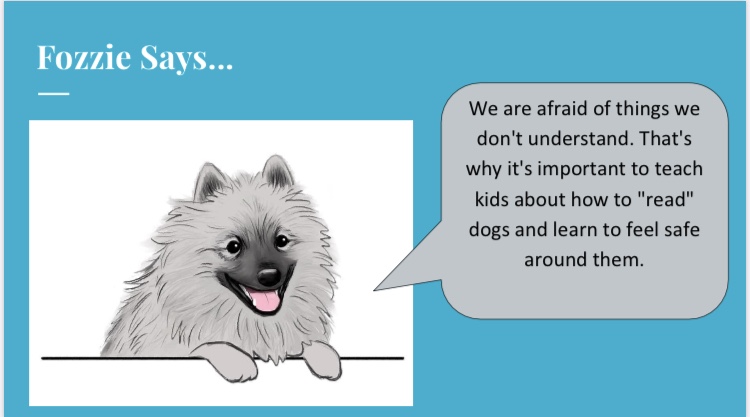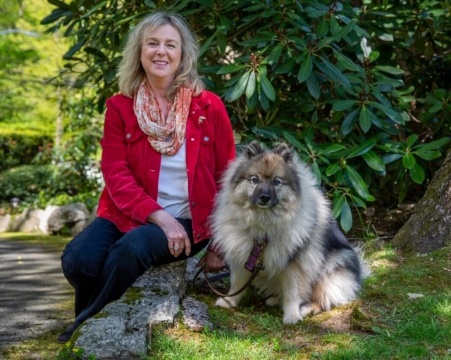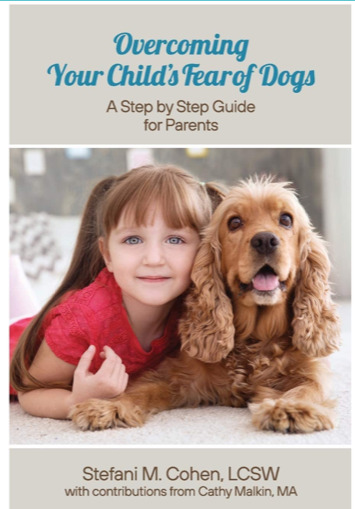Overcoming Your Child’s Fear of Dogs: A Step-by-Step Guide for Parents by Stefani M. Cohen, LCSW is a great resource for anyone who knows someone who is afraid of dogs. It outlines how cynophobia (fear of dogs) develops in children, provides proven techniques to overcome the fear and several chapters on helping kids learn to understand and “read” dogs. The last chapter in the book describes the benefits of the human animal bond and all the many things children can gain from having a relationship with a dog.
Most of us know a child who is afraid of dogs. My own daughter, at the age of 4, became so afraid of dogs that she refused to go on playdates or family outings because she was afraid she might see a dog. I searched high and low for information that could help. There was very little out there. Using my parenting coach hat, my LCSW therapist hat, my mom hat and my dog lover/humane educator hat, I created my own 10 step method. In my private practice my therapy dog, Fozzie, assists me. I have now written the book that I wish was available to me when my daughter was younger and afraid of dogs.
The fear of dogs affects millions of people, many of them children. When it is not addressed it can significantly impact the child and the family’s daily life. Some phobias, such as the fear of heights or spiders, do not impact kids the same way. This is because it is possible to go through life avoiding these triggers. However, it is virtually impossible to avoid dogs in daily life. Yet, children who are afraid of dogs will try and avoid them at all costs. Sometimes these kids even put themselves at risk by running into traffic to avoid encountering a dog on a sidewalk or in a park. When a child has a strong fear of dogs it is important to address the fear as soon as possible, because the longer it goes on, the more entrenched it becomes. If left untreated, cynophobia can turn into a significant source of anxiety, family discord and social stress. Most children do not grow out of this fear.
Children are afraid of things they don’t understand and need information about how dogs behave and communicate. They also need to know how to stay safe around them. Dogs rarely bite out of the blue. We need to teach kids to respect dogs and to educate them about dog body language signals that say “I’m uncomfortable” or “I need space”. In this way children can avoid an unpleasant interaction with a dog, or worse, a dog bite. As parents, we teach kids how to look both ways before crossing the street, to “stop, drop and roll” in a fire and not to touch the stove. But most parents don’t teach children about dogs and how to know when it’s safe to approach and greet a dog and when it’s best to stay away.

My technique uses exposure therapy with a real dog to provide children with safe, supervised and positive experiences so that they learn to feel safe and in control around dogs. Exposure therapy involves starting with more benign and less threatening situations that help an individual confront their fears in a manageable way. The goal is to gradually build the person’s confidence so they can handle more frequent and longer exposures to the situation that generates their fear.
Exposure therapy is the best approach to help children overcome their fear of dogs. When using this technique to treat a child’s fear of dogs, the child’s fears should gradually diminish as their controlled exposure to well-behaved dogs increases. The exercises outlined in the book go from just being near a dog to eventually petting and walking a well behaved and friendly dog. This can take as little as one session or as many as five or six sessions.


Greeting Fozzie
There is much to be gained when a child faces their fears. Many children have shared with me that they have felt ashamed by their fear of dogs. Well-meaning adults and friends often pressure kids to interact with dogs without taking the child’s needs into account. It is very important to acknowledge that their fear is real and to go at the pace with which your child feels comfortable. Kids feel a lot of pride when they face their fears and also relieved that they no longer have to worry if they will encounter a dog.
When a child overcomes their fears they gain additional benefits such as:
- Self-confidence
- Self-esteem
- Respect
- An ability to cope with anxiety and fear
- The confidence to speak up about what they need
- Greater awareness of their feelings
My overall goal is to help children learn to feel safe and in control around dogs. While my wish is for every child to know the love and affection of a dog, I realize that it is not always feasible. However, I do want kids to be able to live their lives free of the fear of dogs. It is possible to help kids overcome their fears with the help of knowledgeable and supportive adults.

Overcoming Your Child’s Fear of Dogs: A Step-by-Step Guide for Parents is available on Amazon.
.

